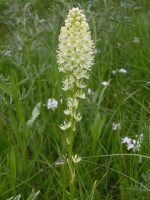
Also known as black snakeroot, this herbaceous perennial bulb is a member of the bunchflower family, Melanthiaceae, that also includes trillium and false hellebores. It is native to western North America from southern British Columbia to California, and east to Utah, Nevada, Colorado, Nebraska and the Dakotas where it grows in a variety of habitats including meadows, sagebrush slopes and montane forests. Growing 1-2’ tall, the plant has a .5-1.5” wide bulb that looks like an onion but lacks its odor, and smooth grass-like basal leaves up to 20″ long. Dense pointed terminal racemes 2-8″ long carry six-petaled, creamy white flowers from spring until mid-summer. The fruit is a three-parted capsule held on an elongated stalk. All parts of the plant are poisonous to both livestock and humans. The genus name, Toxicoscordion, is the Greek word for poison garlic, and refers to the bulb of the plant. The specific epithet, venenosus, is from the Latin word venenum, meaning poison.
Type: Herbaceous perennial bulb
Bloom: Six-petaled creamy white flowers in dense pointed terminal racemes 2-8″ long from spring until mid-summer.
Size: 1-2’ H
Light: Full sun
Soil: Average, dry to moist, well-drained
Hardiness: Zones 4-8
Care: Divide when necessary
Pests and Diseases: None of significance
Propagation: Seed, division of bulb off sets
Companion Plants: Glacier lily, lupines, sticky purple geranium
Photo Credit: Matt Lavin, Wikimedia Commons